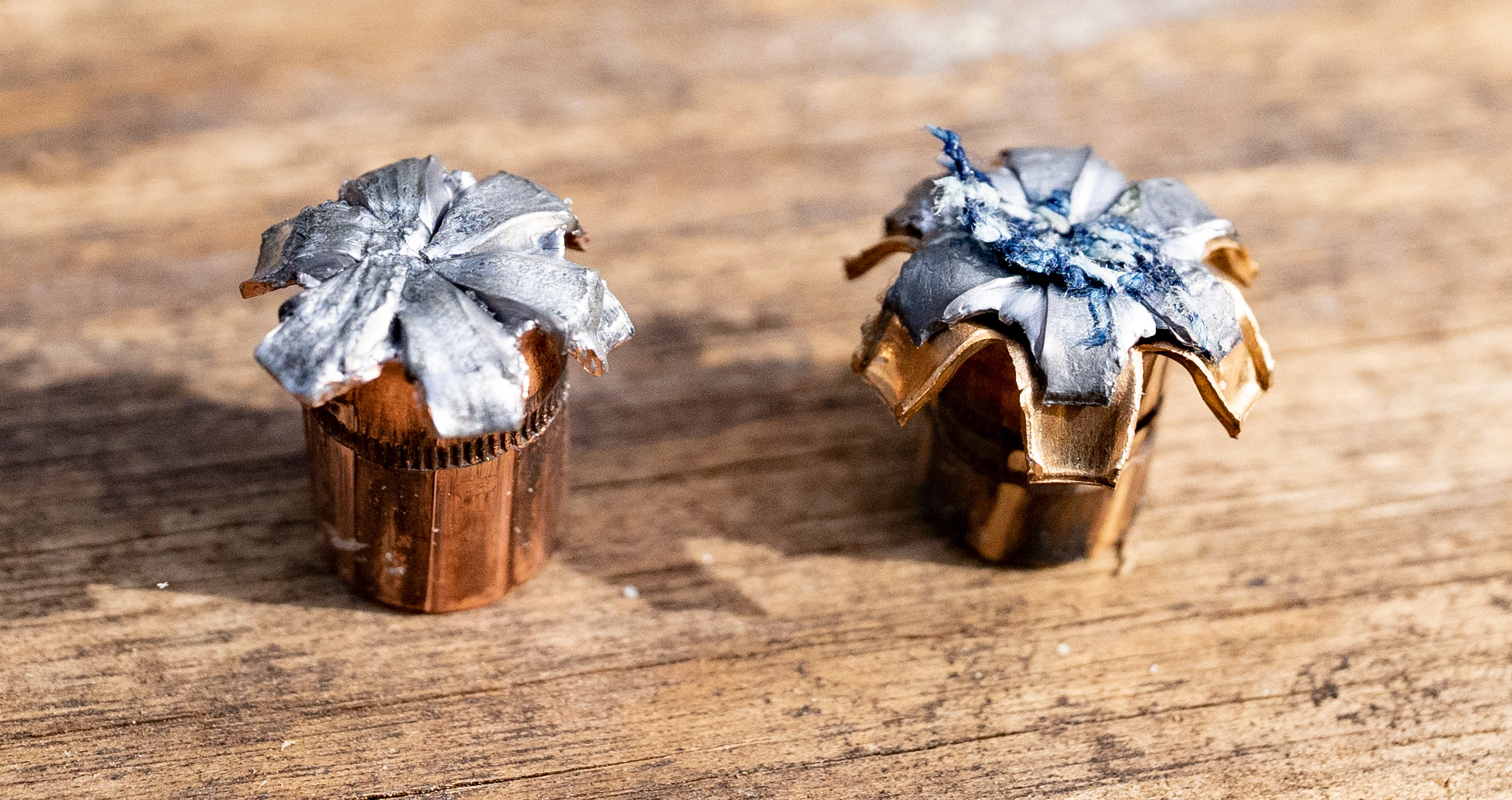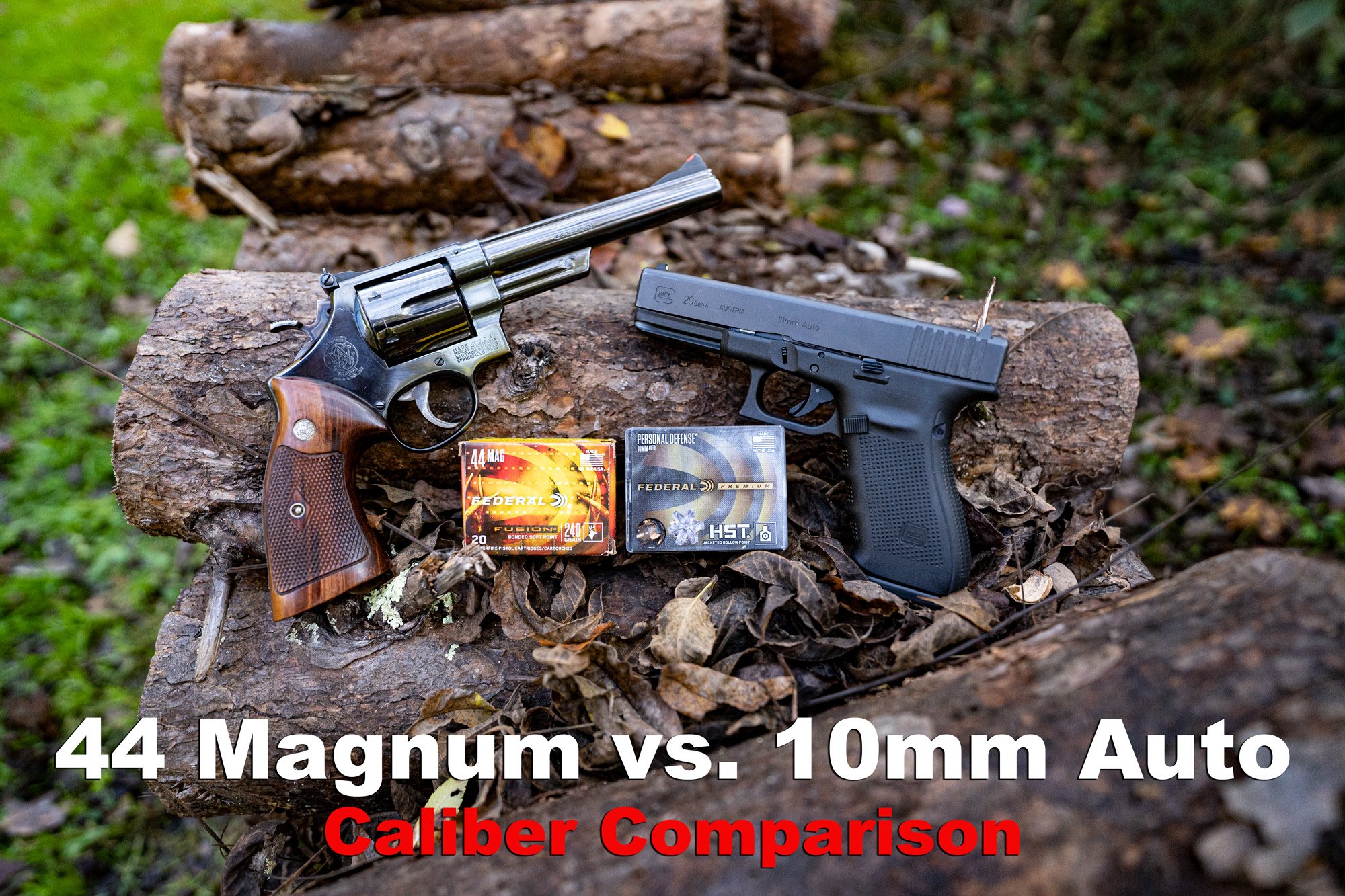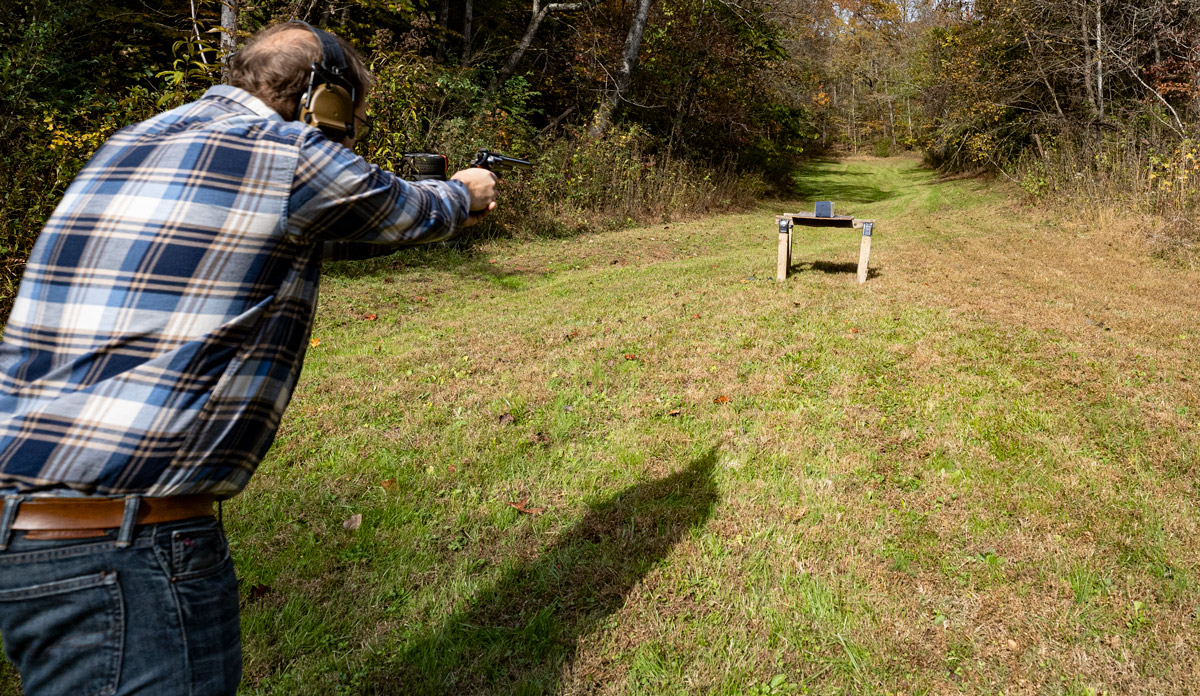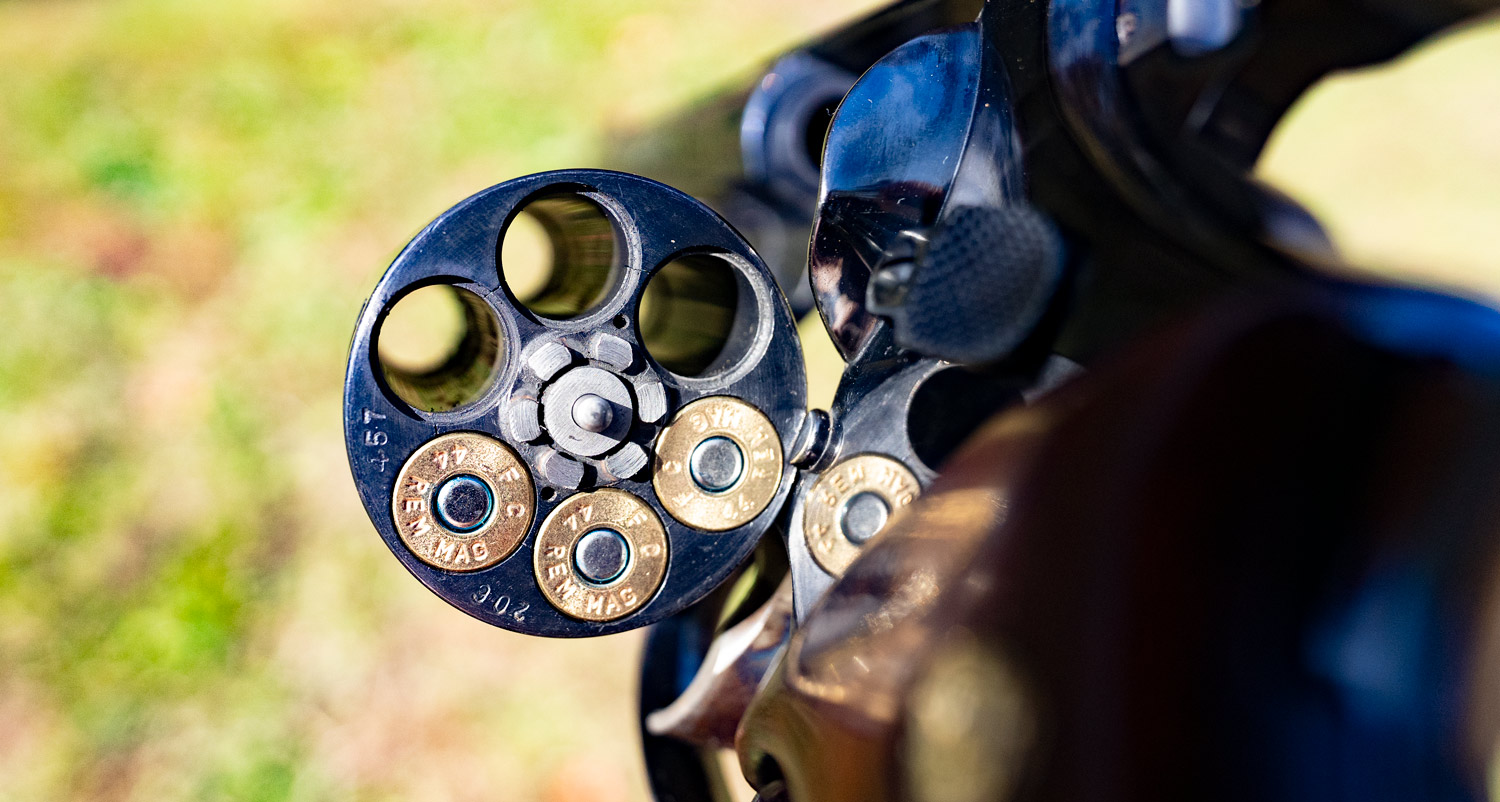A thorough comparison of 44 magnum vs 10mm with a look at ballistic and self-defense capabilities of each caliber.
Perhaps you’re looking for more power from your handgun. Perhaps you’ve become bored with firing the typical 9mm Luger or .380 ACP and want to put more force into your hands. Perhaps you want a handgun that is not only fun at the range, but can be a reliable tool on a hunt.
Whatever your reasoning, if you are in the market for a larger handgun cartridges, two of the most popular and powerful options are the .44 Remington Magnum (aka “.44 Magnum” or “.44 Mag”) and the 10mm Automatic (aka “10mm Auto” or just “10mm”).
Providing more power than practically all other cartridges available on store shelves, these two rounds are a great option for any gun owner who wants to enhance their performance.
Which one is right for you? To decide, you’ll have to consider your preferences for speed, energy, and recoil. But before that, you might make the choice based solely on your preferred handgun style.
44 Magnum vs 10mm: Differences
| .44 Rem Magnum | 10mm Automatic | |
|---|---|---|
| Released | 1955 | 1983 |
| Bullet Diameter | .429 inches | .4 inches |
| Base Diameter | .457 inches | .425 inches |
| Neck Diameter | .457 inches | .423 inches |
| Case Length | 1.285 inches | .992 inches |
| Overall Length | 1.61 inches | 1.26 inches |
| General Bullet Weights | 180 to 300 grains | 155 to 200 grains |
| Typical Firearm | Revolver | Semiautomatic pistol |
Overall Length
If you stand these cartridges side-by-side, the main difference you’ll notice is overall length. Bullet and neck diameters, while different, are not drastically distinct. However, the .44 Magnum is noticeably longer than 10mm Auto ammunition. It has a longer case, which results in a longer overall size.
Bullet Weights
While there is some overlap in bullet weights, the typical .44 Remington Magnum is significantly heavier than an average 10mm projectile. The 10mm Auto starts at about 150 grains and goes as high as 200 for the majority of products; 180 grains, or somewhere in that range, seems to be a fairly standard bullet weight. The .44 Mag, however, starts at 180 grains and goes as high as 300. Most .44 Magnum ammo you’ll find with online retailers and store shelves are about 240 grains.
A little foreshadowing: Heavier bullet weights, combined with a longer overall length, will have clear implications when we start looking at cartridge performance.
Handgun Choice
Regardless of size, speed, energy, and numerous other factors, if you prefer revolvers over semiautomatic pistols, or vice-versa, you may have already made your choice. The .44 Magnum mostly loaded into revolvers, although there are some pistols available, while the 10mm Auto is made almost exclusively for semiautomatics. If you have a strong preference for one or the other, you may have already made your choice.
.44 Magnum vs 10mm Auto: Performance
Comparing cartridges can be tough, as there are so many products of varying uses and weights, from dozens of manufacturers. However, by comparing cartridges from the same product line, we get a fairly clear picture on the differences between the .44 Magnum and the 10mm Auto. To be fair, this is a small sample size, but it still helps us understand these two cartridges.
| Muzzle Velocity (fps) | 50-yard Velocity (fps) | |
|---|---|---|
| .44 Mag: 200-gr Monoflex (Hornady) | 1,475 | 1,310 |
| 10mm Auto: 135-gr Monoflex (Hornady) | 1,315 | 1,108 |
| .44 Mag: 240-gr American Eagle (Federal) | 1,230 | 1,117 |
| 10mm Auto: 180-gr American Eagle (Federal) | 1,030 | 970 |
| .44 Mag: 240-gr FMJ Flat (Magtech) | 1,617 | 1,439 |
| 10mm Auto: 180-gr FMJ (Magtech) | 1,230 | 1,122 |
Velocity
Speed is a stat that impacts all other performance variables. A faster bullet hits with more energy, penetrates deeper, expands better and tends to maintain better trajectories and wind resistance. As we can see from the stats above, the .44 Remington Magnum is typically the faster round. This is not surprising, as it has more propellant (Remember the larger case?) which pushes the bullet forward with greater force.
In all three comparison, we see that the .44 Magnum is faster for both muzzle and downrange velocities.
Winner: .44 Remington Magnum
| Muzzle Energy (ft-lbs) | 50-yard Energy (ft-lbs) | |
|---|---|---|
| .44 Mag: 200-gr Monoflex (Hornady) | 966 | 762 |
| 10mm Auto: 135-gr Monoflex (Hornady) | 518 | 368 |
| .44 Mag: 240-gr American Eagle (Federal) | 806 | 665 |
| 10mm Auto: 180-gr American Eagle (Federal) | 424 | 376 |
| .44 Mag: 240-gr FMJ Flat (Magtech) | 1,395 | 1,104 |
| 10mm Auto: 180-gr FMJ (Magtech) | 605 | 510 |
Energy
A full-size SUV traveling at 40 miles-per-hour is going to smash into a wall with more force than a compact car traveling at 30 miles-per-hour. The same principle applies to bullets. In this case, the heavier bullet of the .44 Magnum, which is traveling at a faster speed, will strike a target with greater energy than the 10mm Auto. This is, in fact, a runaway victory for the .44 Magnum, as it nearly doubles (and in one case does double) the muzzle and downrange energy of the 10mm Auto.
The 10mm Auto is not weak, and outpaces many popular cartridges, but it simply can’t match the tremendous force of the .44 Magnum.
Winner: .44 Remington Magnum
10mm vs 44 Magnum for Self-Defense
So, how does all the ballistic data add up in a self-defense situation? To give us an idea, we set up some Clear Ballistics gelatin with a 4-layer cloth barrier at the shooting range. We fired rounds of Federal Fusion 44 Magnum and Federal HST 10mm ammo into the gel.
This gelatin is designed to simulate what would happen if you used a firearm to neutralize an attacker.

We fired three rounds of each caliber into the blocks.
The 10mm ammunition gave us an average penetration of about 22-inches. In the photograph above, we’ve circled the 10mm HST bullets in blue. The penetration result we documented is slightly farther than what the Federal Bureau of Investigation recommends for a self-defense load.
We lost one of our 44 magnum rounds through the top of the gel block. You can see the remaining two rounds circled in green penetrated significantly deeper than the 10mm. In one case, we had to get a third gel block as the round penetrated about 38-inches.
Expansion

10mm vs 44 Mag Recoil
Some shooters are not sensitive to recoil, while for others it’s a major concern. Regardless of your preferences, we can say with confidence that the 10mm Auto will, in most cases, deliver a more manageable recoil.
With lighter muzzle energies compared to the .44 Magnum, the 10mm Auto is already positioned for easier recoil. But there is also the revolver vs. pistol factor. Generally speaking, autoloading pistols are considered to have easier recoil, as the reloading function absorbs some of the backward energy.
Winner: 10mm Auto
Should You Choose 44 Mag or 10mm?
After all that, it still might seem like a difficult choice. But consider how you expect to use the weapon; this can guide your selection between the .44 Magnum and the 10mm Auto.
Choose the .44 Magnum…
If you prefer a hard-hitting, large-bore cartridge over a revolver, the .44 Magnum is probably the right choice for you. Shooters who have little concern for recoil, as well as hunters who want a viable handgun option for medium-sized game, will find decades of enjoyment from a sturdy .44 Remington Magnum handgun.
Choose the 10mm Auto…
If you expect to use the cartridge for target shooting, a bit of hunting, and personal protection, the 10mm Auto seems like a more practical choice. It has less recoil and handguns for this round can usually load more shots. The weapons are usually better options for conceal carry, making the 10mm a more versatile round.
Find a Large Variety of Affordable Handgun Ammunition
Whether you choose the .44 Magnum, the 10mm Auto, or both, you’ll find top-quality ammunition at ammotogo.com. Visit our site and you’ll find affordable rounds for target practice, hunting, and personal defense.




